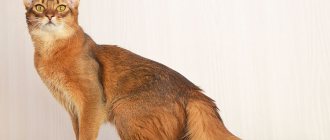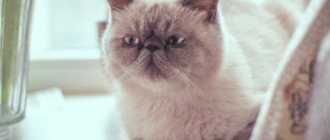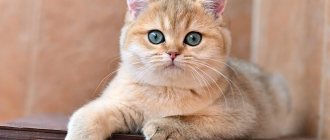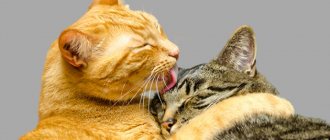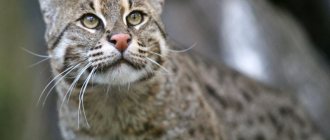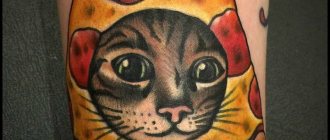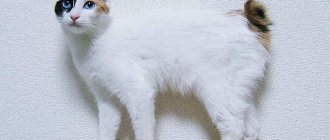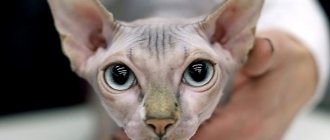- Pets
- >>
- Cat breeds
* Here is a photo of a typical representative of the Burmese cat breed . You can send us photos of your animals by email, and we will post them on the website. Don't forget to send your pet's name.
Other breed names:
Sacred Burma
Video
* We invite you to watch a video about the Burmese cat . In fact, in front of you is a playlist in which you can select and watch any of 20 videos about a given cat breed by simply clicking on the button in the upper right corner of the window. In addition, the material contains quite a lot of photos. By looking at them you can find out what a Burmese cat looks like.
In this article:
|
Rate the material!
[Total votes: 0 Average: 0]
The sacred animal of ancient Burma is the Burmese cat . An unusual breed of cat with long hair, sky blue eyes and a beautiful point color. This breed has innate good manners and excellent training abilities.
Feeding recommendations
The Burmese cat's diet must be properly balanced. Breeders recommend feeding the animal with premium or super premium dry industrial formulas. Suitable brands of food for this breed: Hills, Royal Canin, Pronature.
Those who prefer a natural type of nutrition need to remember that the share of meat in the total amount of food consumed is 80%. The remaining 20% are additives in the form of vegetables, cereals, eggs, and dairy products. Lean meat varieties are suitable for feeding a Burmese cat:
- veal;
- poultry fillet;
- beef;
- rabbit meat.
Once a week you can give your pet sea fish without bones. The preferred offal is heart and chicken gizzards. Liver causes digestive upset, so it is given in small quantities.
Prohibited products include:
- bones;
- River fish;
- fat meat;
- fried, salted, smoked food;
- sausages, sausage;
- mushrooms;
- potato;
- bread;
- pasta.
In cold weather, the Burmese should not be allowed outside; the cat can easily catch a cold.
History of the origin of Burmese cats
The origin of this breed is surrounded by beautiful myths and legends of ancient Burma, where these cats lived in temples for many years. An ancient legend says that Burmese cats used to have snow-white fur without any dark spots or markings. One day, robbers broke into the ancient temple in which the sacred statue of the goddess was kept. They wanted to destroy the temple and steal a valuable statue of the goddess.
The abbot of the temple, who was protecting the statue of the goddess, was killed, and his pure holy soul moved into his beloved cat named Singh. The cat, according to legend, stood near the head of his dead owner, the color of his fur changed, and his eyes became blue. The cat screamed shrilly, and the other monks were able to find the strength to drive away the robbers. The enemies failed and fled, and all the cats that lived at this temple received sky-blue eyes, the same as those of the statue of the goddess, and a beautiful golden color.
Interesting fact: In the first decade of the 20th century, cats of this breed were imported to France, where selection work to breed the breed began. However, this breed was almost completely exterminated during the harsh times of the world wars. There were very few cats; some animals died in houses from bombing and shelling, others from hunger.
To prevent the breed from disappearing altogether, Burmese cats began to be crossed with Persian and Siamese breeds. In 1925, this breed was given an official name, and the first exhibition of Burmese cats took place in Italy back in 1926. In 1966, the breed found recognition in Britain, and later in the USA. Today, this cat breed is considered very popular all over the world. These cats with beautiful long hair, sapphire-colored eyes and point coloring are bred all over the world.
Burmese cat - description of the breed
Burmese cats are medium-sized cats with a strong body with strong and well-developed muscles. The height at the withers is about 30 cm, the weight of cats is about 4 kg, males are 5-6 kg. The body is neatly built, the shoulders and hips are approximately the same size, the bones are large and strong. Sexual dimorphism favors males, which means that cats are much larger than cats, and cats have brighter fur colors.
The limbs are small, but strong and muscular, the paws are round. The paw pads are mostly pink, although they can also be colored like the points. Burmese cats have very beautiful, long and fluffy tails, and it is for their beautiful tail and fluffy fur that breeders value them so much.
The head of cats of this breed is large and round. The ears are small and erect. The tips of the ears are slightly rounded. Small hair tassels on the ears are allowed. The eyes are large, round, sapphire blue. The mustache is long. The muzzle, tips of the paw ears and tail are painted in darker colors.
Interesting fact: Burmese cats have beautiful, soft, long hair. Their wool is silky, does not tangle, and has no undercoat. On the cat's back and chest the hairs are even, but in the belly area the hair may be slightly curly. On the chest there is a beautiful collar of long and silky wool.
The gait of Burmese cats is soft and smooth. Cats have innate royal manners; they are neat, calm and majestic. The average life expectancy of Burmese cats is 12-15 years.
Burmese kittens are born almost white, but over time, markings of darker tones appear on the face, paws and tail. In adult cats, the nose and muzzle, ears, tail and paws are painted in dark colors.
Difference from Ragdolls
Ragdolls differ from Birmans in their wedge-shaped head, widely spaced ears, and nose, which has a special proportion - the width is exactly half the length. For Ragdolls, spots on the paws are allowed, while for Burmese this feature is a factor for disqualification at the exhibition. In addition, representatives of this breed differ in character and temperament. Cats are calmer, less active, and also have the ability to relax the muscles of the entire body, hence the name “rag doll.”
Two Ragdoll cats
Popular colors of Burmese cats
Burmese cats have a beautiful point color.
There are quite a lot of different colors, but here are the most popular ones:
- SBI n - chestnut or chocolate point. This color is considered the brightest and most contrasting. The points are bright brown, evenly and completely colored. An even diamond-shaped mask should stand out on the cat’s face. There should be no light areas on the points; white spots on the points are not allowed at all. At the age of 2.5-3 years, the fur on the back and sides darkens slightly; in rare cases, the animal’s abdomen darkens;
- SBI-21 this color is characterized by dark brown striped points. The color is very similar to the previous one, but the points have dark stripes;
- SBI a - blue or silver point. The general color of the animal is white, and the points are cold silvery tones. The points must have an even color. On the face there is a diamond-shaped mask of gray color, the ears are gray. On points, light colors are undesirable, but acceptable. By the age of 2.5-3 years, the back and sides of the animal are covered with a so-called silvery cloak. In rare cases, the pet’s belly may also darken;
- SBI a 21 - striped silver point. The color is the same as the previous one, but the points are striped;
- SBI b - classic chocolate point. This color is not as bright and contrasting as the previous ones. The tail and dark points should be well and evenly colored. It happens that the points are very light; they can be the color of milk chocolate. The mask on the muzzle is not wide. The diamond shape of the mask ends behind the outer corners of the eyes, and the forehead is covered by the mask approximately to the middle. Light areas on points are undesirable; the body body does not darken with age;
- SBI b 21 - the same chocolate point only with stripes. The classic color is white combined with light red striped points. Some have a red color on the nose, palate and paw pads. Over the years, the animal's body does not darken;
- SBI c - lilac point. Pearl-colored points. The mask on the face, like that of the blue point, is not wide, the points are evenly colored in pearlescent color. The sides of this color never darken;
- SBI c 21 - lilac point with stripes.
Appearance
The Sacred Burma has a medium-sized body with a graceful head. Its appearance is harmonious and characterized by symmetry in everything: the light-colored skin has spots, symmetrically located, the fur is fluffy, light, elongated on the legs in the form of panties, thickening on the neck, forming a beautiful collar. The tail is small and covered with silky fur and is particularly coquetry.
Head
The Burmese skull is oval, strong, the forehead is convex, the cheeks are full, the chin is rounded. The nose is of medium length, proportional to the head, starting below the eye line, slightly convex, for which it received the name Roman. The nostrils are placed low. In profile, the upper part of the muzzle is sloping. The hair on the top of the head is shortened, thickens on the cheeks, and is very long towards the neck. Massive jaws, developed chin, correct bite. The ears are of medium size, rounded at the tips, located symmetrically to each other, proportional. The eyes are round-oval, bright blue.
Weight
The average adult of this breed weighs approximately 4 - 6 kg.
Frame
Cats are smaller than cats. The body is medium in size, oblong, stocky. The limbs are massive and strong. The tail is fluffy, proportional to the length of the body. The coat on the body is a beige-golden hue, not too long, without undercoat, silky in texture, which avoids matting, and white wavy on the tummy.
Gloves and socks on the paws should be perfectly white, maintaining symmetry. The toes on the hind legs end slightly higher than the gloves on the front legs. At the back they have the characteristic features of the Burmese, a spur in the form of an inverted letter L, at the level of the hock joint.
Character and habits of Burmese cats
Sacred Burma is a true personification of wisdom and tranquility. These animals hate noise and fuss. Instead of active games, Burmese cats like to sit and calmly watch what is happening around them. They are very calm, it is very difficult to anger a Burmese cat, and even if this can be done, it will not hiss or rush at the offender, but will simply get up and calmly leave with royal majesty, not wanting to get involved in a conflict.
Interesting fact: Burmese cats are not only pets, but also true friends. They are extremely loyal to their owner, very sociable, but at the same time they do not tolerate bad treatment. Cats of this breed are distinguished by high intelligence and innate good manners. They are always majestic and calm, they understand well what a person says, and quickly get used to the tray, scratching post and sleeping place.
Animals can treat children differently depending on the character of a particular individual and mood. These cats are not very playful, but can be quite tolerant of children. Relations with other animals are calm. Burmese get along quite well with dogs, provided that the dog does not offend the cat. Rodents and birds can become prey for a cat, so animals should not be kept in the same room.
The main problems usually arise with unsterilized cats and female cats. At a time when the cat’s nature demands its way, the animal can become aggressive, meow and especially fiercely guard its territory. Males mark their territory. Castrated and sterilized cats always behave calmly and decently. For older people, Burmese will be excellent companions who will not let you get bored.
Character
The sacred Burmese cats inherited the best features from their conditional ancestors, Siamese and Persians. They are both loving and unobtrusive, not as phlegmatic as the Ragdoll, because despite their softness, they have a bright character. The pet loves its owner very much, but has a positive attitude towards all family members, dogs, and other pets.
He loves to sit in his arms, but if he understands that a person is busy, he will not impose himself, unlike the Burmese, which is distinguished by its cheerfulness. Burma will wait for a favorable moment and will stay somewhere nearby. They are not bossy and demanding like Siamese cats, but they have inherited a fairly high level of intelligence. By nature, Burmese are very curious, actively exploring the surrounding space.
Interesting facts about Burmese cats
Sacred Birman kittens are born with soft, snow-white fur, which gradually darkens with age. The coloring of the Burmese cat is a type of albinism. Wool is dyed dark in so-called “cold places” where blood circulation is poorer. You should also remember that if a cat is exposed to the cold for a long time, its fur may darken prematurely.
A unique fertility record was set by the Burmese cat. A mother named Antigion gave birth to 19 kittens in one litter. The Birsk breed includes a cat that has set a record for longevity. On average, cats live from 12 to 15 years, but the Catalina cat from Australia was able to live as much as 35 years. This cat is listed in the Guinness Book of Records as the oldest cat in the world.
Burmese kittens are born with disproportionately large ears, but over time the kitten's head and body grow into correct proportions. Shorthaired Birmas are very rare, but they do exist. The main characteristics of the shorthaired Burmese are white socks on the paws, short hair and a small undercoat. The cat's head is large and round, its eyes are sky blue.
Seals of this breed are excellent hunters; they will happily stretch their bones while hunting in the garden. Seals like to hunt more because of sporting interest; domestic cats are unlikely to eat their prey, but they can bring their trophy to the owner in order to be praised.
Cats of this breed are not adapted to living in cold climates outside homes. These cats are very heat-loving, they quickly catch a cold outside in bad weather, and in houses these animals find the warmest place to rest. By the way, only Burmese people like to sleep under a blanket at night.
Peculiarities
There are many positive features. Their balanced character plus high intelligence makes them friendly and calm. They don’t remember insults, are easy to train, develop good habits, and are non-aggressive. The almost complete absence of undercoat makes regular grooming easier. Blue-eyed pets do not shed as much as other fluffies. The coat is delicate, silky, and easy to comb, unlike the Neva Masquerade, a long-haired breed with a similar color.
The disadvantages include a number of points:
- Loud noise is annoying, you need a quiet place to rest.
- They resolutely refuse food they don’t like.
- Leaving someone alone is a bad idea and can cause stress.
- Drafts and coolness can cause disease due to the small undercoat.
- The cost is high.
Negative reviews are almost never found. A friendly, handsome guy with a bright appearance lives up to his reputation as a good pet. If a small child causes severe pain, the mustachioed beauty is capable of displaying aggression.
“Many owners note that such kittens are playful and restless. By the age of two or three, they acquire some solidity, their delicacy becomes more obvious. Throughout their lives they maintain a high need for communication and curiosity.”
Pros and cons of Burmese cats
Advantages of the Burmese breed:
- Burmese cats are very beautiful. The aristocratic appearance speaks of the elitism of the breed. This breed includes the beauty of the Persian, Siamese and Burmese breeds. The cats have beautiful fluffy point-colored fur, blue eyes and a huge fluffy tail;
- Burmese are able to understand the feelings of the owner and adapt to the mood. If the owner is sad, the cat will always come to the rescue and try to support the owner by gently purring and trying to attract attention;
- Calm and flexible character. It is very difficult to anger a cat of this breed, and even if this happens, the cat will not take revenge or hiss, most likely, he will simply leave without wanting to enter into a conflict;
- Burmese have excellent health; no genetic diseases have been identified in cats of this breed, and with good care, the cat can live a long and happy life;
- Cats of this breed do not require complex care despite their rather long hair. The animal's fur has an even, smooth structure and does not tangle or mat;
Disadvantages of the breed:
- Cats of this breed should not be allowed outside during the cold season as the animals are not adapted to cold climate conditions. Burms get cold quickly, and their coat can darken prematurely in the cold;
- Burms do not like intrusive affection; if the cat is in a bad mood, it may avoid people;
- Pets of this breed are not suitable for families with babies and small children. These animals do not like to be cuddled or carried. They don’t like noise and fuss, and although Burma won’t hurt a child, they won’t play for hours and tolerate bad treatment;
- Unneutered cats mark their territory, and unsterilized cats can become aggressive and meow at night;
- Price. Kittens of the Burmese breed cost from 40 to 100 thousand rubles, depending on the pedigree and nursery, which is not cheap at all.
How to choose a Burmese kitten and its price
Kittens of this breed are definitely not in the cheapest category. A Burmese cat kitten costs about 40–100 thousand rubles. The price varies so much depending on the cat's pedigree.
Some rules for choosing a kitten:
- The main thing is to find the same trusted breeder who will tell and show everything.
- Once you have chosen, look at it from all sides - evaluate its appearance. The gait should be smooth, the coat and skin should be in order, the tail should be healthy. No black spots. Meet the kitten's parents, if possible. Consider them too.
- Be sure to ask the breeder to provide you with all the necessary documents regarding this cat.
- The optimal time to buy a kitten and wean it from its mother is 2–3 months. During this time, the kitten should know exactly what a tray and a scratching post are.
- Choose a cheerful, active, playful and affectionate kitten.
- Do not buy kittens from online sites and at very low prices. This definitely indicates an incorrect pedigree or the presence of diseases.
Once you have found a sacred cat in your home, you will now have something to remember. Incredible beauty will delight you every day, and high intelligence and tenderness will not let you get bored.
Give your pet care and affection, and she will answer you in kind.
Breeding Burmese cats
Breeding the Burmese cat breed is not an easy and extremely important task, because the health and vitality of the offspring depends on the correctly selected parents and their health.
Therefore, when breeding cats of this breed, you must adhere to the following rules:
- Males and female cats with any congenital abnormalities cannot be used for breeding;
- Cats of any breed used for breeding must have a mustache;
- Breeding cats must have a certificate that confirms the male health of the stud cat;
- A breeding cat can be used for mating if she has had no more than 3 births in the last 2 years;
- A cat that cannot give birth naturally or has previously had a caesarean section cannot be used for breeding;
- There should be a break of 3 weeks between matings with different cats;
- All animals used for breeding must be microchipped;
- Cats with an umbilical hernia, deafness and other diseases are not allowed for mating;
- Mating is carried out on the territory of the male. For mating, a separate room should be allocated where the animals can quietly retire. Before mating, animals must undergo a medical examination;
- During mating, the owners must provide the female with the usual food and tray so that the animal feels good;
- Childbirth must be supervised;
- To register kittens, the owner must provide the kittens themselves, a mating certificate filled out on the club's letterhead with the signatures of the owners of both parties. The direction given by the instructor for this mating. The animal's name is included in documents in any language at the request of the owner;
- Animals without a pedigree cannot participate in mating; they must be sterilized;
- Kittens under 12 weeks cannot be separated from their mother. Animals can be transferred to another home after the kittens are weaned from the mother's breast and receive all necessary vaccinations.
Buy Sacred Burma - tips and tricks
Before buying such an expensive and rare individual, you need to clearly understand the purpose: for love, for exhibition or for breeding? In the first case, an inexpensive pet is suitable, in the second and third - a show or breed. The color takes many years to develop, so a purebred animal should be taken only from trusted breeders.
In addition to the pedigree, well-known nurseries such as Adoration provide an F-1 certificate, a veterinary passport and other documentation related to participation in exhibitions. The transaction is formalized by an agreement with signatures and seals. It wouldn't hurt to get preliminary information about the nursery from the club.
Breeders do not always give valuable kittens with good characteristics to new hands. For this rare breed, joint ownership is widely practiced, which allows the kennel to monitor the fate of the ward and take part in it. The new owner receives full information support and assistance from the breeder. You can take an animal into joint ownership for up to three years, then the animal is sterilized and left in the full care of the new owner.
Price
Even an individual without documents is expensive - about 3-7 thousand rubles. Breeders have completely different prices:
- pet class - from 20,000 rubles;
- breed class - from 35,000 rubles;
- show class - from 70,000 rub.
The figures are approximate, how much a Burmese fluffy costs depends on what the individual looks like and other individual characteristics. Ordering from abroad will cost much more.
Caring for Burmese cats
Cats of the Sacred Burmese breed are unpretentious and do not need any special tricks. Caring for them is quite simple and anyone can handle this task. Before bringing the cat into the apartment, the room must be prepared. You need to go through your home and remove all protruding wires and cables. Put away expensive porcelain, gadgets and other items that your cat might accidentally break.
Also, the room needs to be made safe, all cracks where the cat could get stuck should be closed. Tightly cover toxic substances that could poison the animal. In addition, the animal needs to have its own personal space. The cat needs to buy a soft and comfortable bed, a tray and a place for food, equipped with large bowls. The cat will also need a scratching post and toys. For trips to the veterinarian, it is worth purchasing a carrier.
In general, caring for a cat is not difficult. You need to bathe your cat once every 3-4 months with a special shampoo. The eyes and ears of the animal are examined and carefully wiped with a cotton pad. Nails are trimmed with special scissors every three weeks. Despite the long hair, it does not cause much trouble. Once a week, the animal must be combed with a special soft comb to remove dead hair.
Fun fact: Raising Burmese cats is usually easy. Cats feel their owner well and quickly understand what is required of them. The main thing is not to miss the moment and explain to the cat the rules of behavior in your home from childhood. Animals should not be allowed to scratch furniture or climb onto tables. A cat's litter box training is usually done by a breeder.
Burms don't tolerate shouting and they especially don't like being shouted at, so try not to do this. When committing negative actions, switch the animal’s attention to toys. Sacred Burmas do not tolerate cold; there should be no drafts in the room where the animal is kept.
Diet of Burmese cats
Burmese cats are good judges of what they eat. They are able to control themselves and not overeat. You can create your pet's diet using only dry food. Dry food is completely balanced and contains all the necessary supplies of vitamins and microelements.
Sometimes you can pamper your cat with canned food. If you want to create a cat’s diet from natural products, do not forget that it must be balanced.
The daily diet should include:
- Thermally processed meat (chicken, turkey, rabbit, lean beef);
- Thermally processed fish of low-fat varieties. Under no circumstances should you give your cat smoked or salted fish;
- Liver, lung, spleen;
- Cereals (buckwheat, pearl barley, oatmeal);
- Dairy products (kefir, cottage cheese, sour cream);
- Boiled vegetables.
Chicken or quail eggs can be given in small quantities. You should not feed the animal from your table. Pet food must be prepared separately without adding salt or spices. Pregnant and weakened cats, as prescribed by a veterinarian, are given vitamin complexes that are purchased at veterinary stores.
In addition to food, cats should have clean water in a separate clean bowl. Always make sure that the dishes from which the cat eats are clean; any remaining food must be removed. It is better to leave dry food in reserve.
Maintenance and care
Caring for them is no more difficult than for other long-haired pets. There are procedures that should be performed regularly. If you follow all the rules, the fluffy will be healthy and beautiful. Cannot be kept in cool, ventilated areas. Protective bars on windows are required. It is recommended to brush your teeth and ears every two weeks. The claws are trimmed and trained to use a scratching post. Walking outside is recommended to be done under supervision so that the cat does not get lost.
Grooming
No special grooming is needed. A good salon will find something to offer the owner, but many manage on their own:
- comb long hair every two to three days;
- During shedding, daily brushing is recommended;
- bathe monthly depending on the degree of contamination;
- the use of special shampoos and other hair care products is allowed;
- brush your teeth and ears twice a month or weekly;
- When dirty, the corners of the eyes are cleaned with a cloth soaked in an aqueous solution of vinegar (1:1).
A smooth-haired cat requires almost the same care, in addition to combing. There are special products for cleaning ears and eyes that can be purchased after consulting a veterinarian. Pets accustomed to water from an early age can easily tolerate bathing. To reduce stress, it is recommended not to immerse the animal in a container of water, but to use a hose or shower head.
What to feed
How long a Burmese lives depends directly on their diet. It is allowed to use ready-made food, dry or canned. A diet consisting of natural products must be balanced.
Natural food
Such nutrition completely excludes the use of dishes prepared for people. Salt and any spices are not allowed. Meat makes up 70% of the total diet. The daily norm for an adult is about 200 g. All products must be fresh and of high quality. You can give:
- chicken, rabbit, beef, turkey and other lean meat, which is frozen, treated with boiling water, and then boiled or given raw;
- boiled sea fish, from which the bones have been removed (twice a week or less);
- boiled vegetables mixed with meat, cereals;
- boiled or raw eggs (twice a week);
- green grass (sold in pet stores).
Smoked meats, sweets, fried and fatty foods are strictly prohibited. Adults are not given milk.
Ready food
Dry or canned food must be of exceptional quality, Premium, Super Premium level. Inexpensive food contains additives that can cause an allergic reaction and negatively affect health. This affects the condition of the coat, the functioning of internal organs, metabolism, and the endocrine system.
Experienced breeders recommend using products from trusted brands:
- Royal Canin;
- Orijen,Hill's;
- Akana;
- Felidae
These are balanced formulations containing essential nutrients, microelements, and vitamins. When using dry formulas regularly, you should provide free access to clean, fresh water with a low content of mineral salts. As a reward, you can offer canned food, low-fat boiled fish, fermented milk products, and some shrimp.
Features of feeding
An undoubted positive feature is the ability to control the feeling of satiety. The food can be left freely, there is no danger of overeating, and obesity is excluded. You cannot use low-quality food, such as Whiskas or KiteKat. There are a lot of useless, cheap ingredients, flavorings that cause urolithiasis, gastrointestinal problems, dermatitis, and other serious diseases.
The money saved on food will have to be used to pay for veterinarian services. It is not always possible to regain lost health. Despite their sweet nature and commendable self-control while eating, they are picky in this area. If the animal in the nursery has already been accustomed to a certain type of food, it is recommended to continue feeding it with products of that particular brand.
Diseases and health problems
Despite the long selection history of this breed, these cats are famous for their excellent health. Burmese cats do not have any serious genetic diseases. With age, like cats of any breed, Burmese can develop cardiac diseases, gastrointestinal and kidney diseases. Therefore, once every six months, the pet must be shown to a veterinarian for timely detection and treatment of existing diseases. It is always easier to cure a disease at an early stage than in an advanced stage.
Vaccinations, which must be done on time, will protect your cat from various infectious diseases. Small kittens are vaccinated for the first time at the age of 2-3 months, after which vaccinations are given annually.
Even if the animal does not go outside, vaccinations must be done. Viruses and infections can enter the home on clothes and shoes, and can also be transmitted by parasites. Fleas can enter apartments through ventilation, cracks, from basements and neighboring apartments. Therefore, it is necessary to periodically examine the animal.
Domestic cats and male cats must be spayed and neutered. This is done so that the animal does not suffer. It is better to castrate cats and cats at the age of six months; at this time, animals tolerate this procedure more easily. Neutered cats are prone to obesity, so they need to be fed special food for neutered cats.
Tips for choosing a kitten
One of the peculiarities of Burmese kittens is the absence of a characteristic color until a certain age. Babies are born completely white. The first marks appear only at 1-2 months of life, which is actively used by scammers. You will be able to find out the exact color of your future pet only after 1.5 years.
For safety reasons, choose a certified nursery that is ready to provide a mandatory set of documents for each of the wards. The price for such animals is higher than in advertisements on free boards on the Internet. But they are guaranteed to be healthy, meet the standard, and are even trained to use a tray or scratching post.
